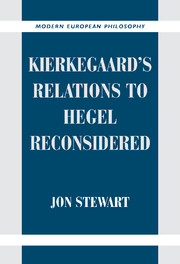Book contents
- Frontmatter
- Contents
- Acknowledgements
- Abbreviations of Primary Texts
- Preface
- Introduction
- 1 Kierkegaard and Danish Hegelianism
- 2 Traces of Hegel in From the Papers of One Still Living and the Early Works
- 3 The Ironic Thesis and Hegel's Presence in The Concept of Irony
- 4 Hegel's Aufhebung and Kierkegaard's Either/Or
- 5 Kierkegaard's Polemic with Martensen in Johannes Climacus, or De omnibus dubitandum est
- 6 Kierkegaard's Repetition and Hegel's Dialectical Mediation
- 7 Hegel's View of Moral Conscience and Kierkegaard's Interpretation of Abraham
- 8 Martensen's Doctrine of Immanence and Kierkegaard's Transcendence in the Philosophical Fragments
- 9 The Dispute with Adler in The Concept of Anxiety
- 10 The Polemic with Heiberg in Prefaces
- 11 Subjective and Objective Thinking: Hegel in the Concluding Unscientific Postscript
- 12 Adler's Confusions and the Results of Hegel's Philosophy
- 13 Kierkegaard's Phenomenology of Despair in The Sickness unto Death
- 14 Kierkegaard and the Development of Nineteenth-Century Continental Philosophy: Conclusions, Reflections, and Reevaluations
- Foreign Language Summaries
- Bibliographies
- Subject Index
- Index of Persons
10 - The Polemic with Heiberg in Prefaces
Published online by Cambridge University Press: 13 March 2010
- Frontmatter
- Contents
- Acknowledgements
- Abbreviations of Primary Texts
- Preface
- Introduction
- 1 Kierkegaard and Danish Hegelianism
- 2 Traces of Hegel in From the Papers of One Still Living and the Early Works
- 3 The Ironic Thesis and Hegel's Presence in The Concept of Irony
- 4 Hegel's Aufhebung and Kierkegaard's Either/Or
- 5 Kierkegaard's Polemic with Martensen in Johannes Climacus, or De omnibus dubitandum est
- 6 Kierkegaard's Repetition and Hegel's Dialectical Mediation
- 7 Hegel's View of Moral Conscience and Kierkegaard's Interpretation of Abraham
- 8 Martensen's Doctrine of Immanence and Kierkegaard's Transcendence in the Philosophical Fragments
- 9 The Dispute with Adler in The Concept of Anxiety
- 10 The Polemic with Heiberg in Prefaces
- 11 Subjective and Objective Thinking: Hegel in the Concluding Unscientific Postscript
- 12 Adler's Confusions and the Results of Hegel's Philosophy
- 13 Kierkegaard's Phenomenology of Despair in The Sickness unto Death
- 14 Kierkegaard and the Development of Nineteenth-Century Continental Philosophy: Conclusions, Reflections, and Reevaluations
- Foreign Language Summaries
- Bibliographies
- Subject Index
- Index of Persons
Summary
Prefaces appeared on June 17, 1844, the same day as The Concept of Anxiety. The pseudonymous author, Nicolaus Notabene, refers to himself in the text simply as N. N. These initials correspond, whether by accident or design, to the Latin phrase “nomen nescio,” or “I do not know the name,” which was a typical form of anonym. As the simple title implies, the work is a series of prefaces without the books to which they are prefaces. The author is purportedly a henpecked husband whose wife has forbidden him from pursuing his passion to be a writer, an activity which she takes to be a sign of marital infidelity. While he is thus obliged to desist from writing actual books, he tries to slip out of the prohibition on a technicality, i.e., by writing prefaces. This is purportedly the origin of the eight prefaces, which constitute the eight chapters of the work.
There is evidence that Prefaces was a somewhat ad hoc construction. From Kierkegaard's Nachlaβ, it is clear that he had written most of the prefaces previously for specific purposes before he conceived of the idea for the work itself. Preface I was a reworking of what was originally a satirical text on Heiberg under the title, “A New Year's Gift,” which was to appear at the New Year of 1843–44. Preface II was taken from a draft of a book-review that Kierkegaard planned to write on Christian Winther's Four Novels.
- Type
- Chapter
- Information
- Kierkegaard's Relations to Hegel Reconsidered , pp. 419 - 447Publisher: Cambridge University PressPrint publication year: 2003

